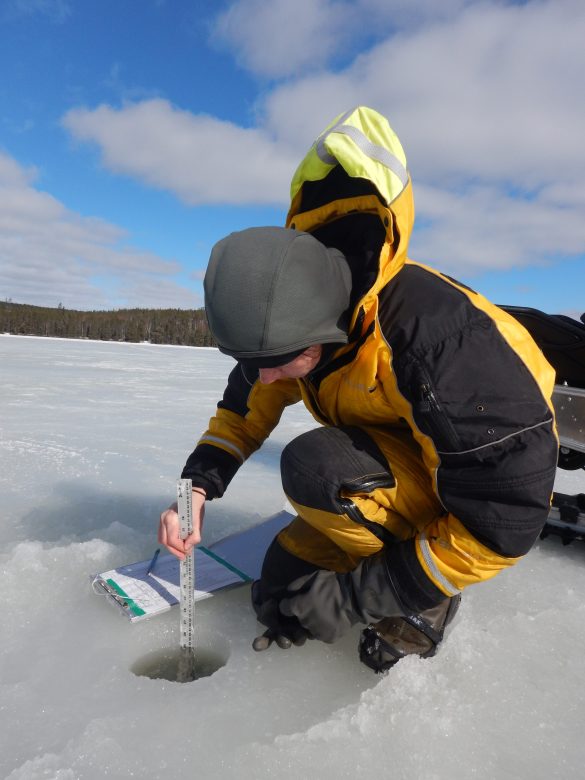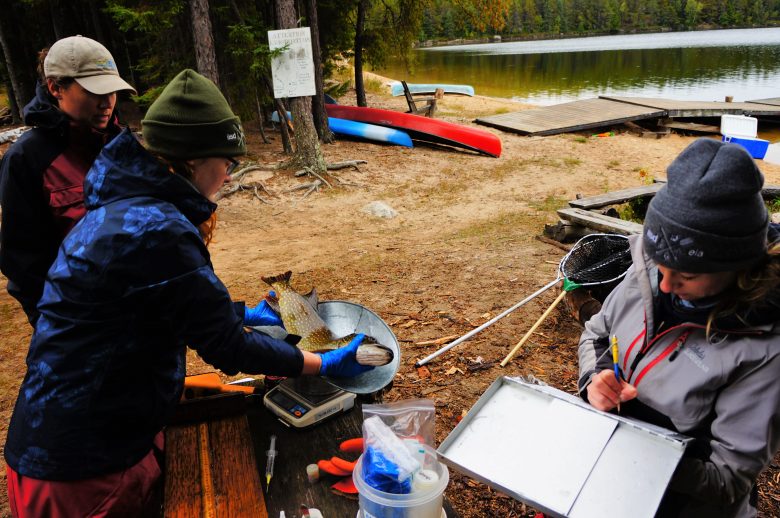Research April 3, 2019
How and Why We Have Monitored Our Lakes for the Last 50 Years
By Paul Fafard, Field Sampling Technician
Here at IISD Experimental Lakes Area, come rain or shine, we are continually monitoring five of our lakes and their watersheds. We consider this Long-Term Ecological Research (LTER) program the backbone of our work. This in-depth monitoring program acts as a natural “control” for our experiments and allows us to determine whether the changes we observe in an experimental lake are due to a manipulation or are simply natural changes occurring across the region.
All LTER lakes are monitored regularly during the summer season for many different aspects of physical limnology, hydrology, water chemistry and aquatic ecology. By monitoring this suite of parameters on these lakes, we can determine a threshold of natural conditions, which we can use to help understand changes in lakes around the world and the growing impacts of climate change.
But what do we monitor? And how do these parameters help us to better understand the health of a lake? Let’s take a look at each of the major characteristics we regularly measure and explore what they can teach us.

While all LTER lakes are monitored regularly during the summer season for many different aspects of physical limnology, we also go out and conduct winter sampling twice a year.
Physical Limnology: The physical aspects of the lake
Basic characteristics like lake depth, lake surface area and water clarity can give us insight into how water temperature and water chemistry change in a lake over time. For example, a large, deep lake with high water clarity will likely experience thermal stratification, whereas a small, shallow lake will not. Temperature structure within the lake will affect gas exchange and can determine where different organisms within the lake are able to survive.
Long-term trends in physical limnology allow us to determine whether lakes are becoming darker, air is getting warmer and fish habitats are getting smaller. Every living organism in a lake depends on physical and chemical aspects of the aquatic ecosystem, which is why understanding how lakes change year after year is so important when considering the health of the ecosystem.
At IISD-ELA, we gather data on light attenuation, water temperature, Secchi depth (a measure of water clarity and colour), dissolved oxygen and conductivity. These data provide us with the fundamentals upon which the rest of our understanding of aquatic ecosystems are based.

Long-term trends in physical limnology allow us to determine whether lakes are becoming darker, air is getting warmer and fish habitats are getting smaller.
Hydrology: How water moves across the landscape
Having accurate information on the movement and storage of water in an aquatic ecosystem means we can calculate things like the amount of heat stored within a lake, the different concentrations of chemical components of a lake and many other variables.
Every living organism in a lake depends on physical and chemical aspects of the aquatic ecosystem, which is why understanding how lakes change year after year is so important when considering the health of the ecosystem.
As part of our LTER program, we monitor lake inflows, outflows and surface levels in order to keep track of the volume of water entering and exiting our LTER lakes. These datasets give us very detailed information on the movement of water into and out of our lakes, which is important when analyzing changes occurring in short time spans, such as after a major storm event. These data are essential when explaining the changes we see in aquatic ecosystems throughout the year.
Water Chemistry: Giving us the full picture
Water chemistry informs us on the “why” of many different aspects of an aquatic ecosystem and can help explain, for example, why organisms can be found in one lake but not another. Many changes we observe in an ecosystem (most of which we cannot see with our eyes) can be explained through chemical analysis.
For example, if a lake has visibly dark, tea-coloured water, it is because of the relatively high concentrations of dissolved organic carbon in the lake, which can affect everything from how the lake stratifies to where fish can live. Similarly, a lake with high concentrations of calcium in the water can harbour animals like freshwater mussels, while a lake with very low calcium concentrations likely cannot.
Through chemical analyses, we can understand how a lake may react to a manipulation or how changes in climate might change the chemical properties of a lake. By curating datasets on different chemical properties of lakes over time, we can understand and predict how lakes change on weekly, seasonal, annual and even decadal timescales.
As part of the LTER program, we collect water regularly throughout the summer season and twice in the winter to monitor changes in different chemical constituents. We also take samples of inflow and outflow water of Lake 239, which allows us to carry out accurate chemical balances of the system.
Algal Ecology: The base of the food web
At the base of the food web are tiny aquatic plants called phytoplankton.
These organisms use dissolved nutrients in the water column and harness the power of the sun to generate energy for themselves. Due to the sheer number of these tiny algae, processes of photosynthesis and respiration account for huge amounts of gas exchange in the aquatic ecosystem.
Algae population sizes depend largely on the availability of nutrients (primarily phosphorus). If phosphorus is in high enough concentrations, algae populations get extremely large (called an algal bloom), which physically blocks light and completely changes the patterns of gas exchange within the water column. The effects of an algal bloom can be as drastic as causing long-lasting periods of anoxia (zero dissolved oxygen) at the lake bottom due to algal decomposition, resulting in the death of many fishes.
As part of the LTER program, we collect phytoplankton when sampling water for chemistry and can measure concentrations of chlorophyll in the sample. This gives us an accurate estimate of algal biomass, which is important in understanding the exchange of gases within a lake. As algae are at the base of the food chain, understanding population dynamics can help us determine why we see changes in lake ecology, especially higher up the food chain like in zooplankton or fishes.
Zooplankton: A major source of food for fishes
Zooplankton are tiny aquatic animals that feed largely on algae or detritus in the water column and are also a main source of food for fishes.
Some are predators of other zooplankton and are most prized as food by fishes, while others are so small or unpalatable that fishes do not eat them at all. Similarly, some zooplankton are ravenous consumers of algae, while others feed strictly on detritus. They all have different roles to play in the ecosystem.
It is important to keep track of how zooplankton community composition or abundance change over time in order to predict changes in fish or algae populations.
Zooplankton collection is carried out every time we sample a lake for water chemistry and physical limnology, giving us a bi-weekly snapshot of changes in zooplankton over each season. For the LTER program, we collect data on zooplankton species counts and community structure, as well as body length measurements and life-cycle description for the Mysis and Chaoborus species. As with algae, understanding changes in zooplankton population abundance and composition can allow us to more fully understand changes we might see in fish populations.
Fishes: Top of the food chain
Fishes are generally at the top of the food chain in aquatic ecosystems. Globally, billions of people rely heavily on fishes as a source of protein in their diet; as such, they are often the focus of policies and management strategies relating to fresh water in Canada and around the world.

Fish in the LTER lakes are carefully monitored in order to follow changes in populations over time. We collect information on biological and morphological measurements of individual fishes such as length, weight, sex and age
Understanding changes in the population dynamics of various species of fishes allows us to see how changes in natural conditions may influence fishes on a broader scale and can inform policy in sustainable management. Not only is the number of fishes an important consideration, but the condition and quality of fishes are also essential for resource managers. As fishes are often top predators, they can contain varying levels of contaminants that may affect human health.
Fishes in the LTER lakes are carefully monitored in order to follow changes in populations throughout time. We collect information on biological and morphological measurements of individual fishes such as length, weight, sex and age. We analyze fishes’ diet through stable isotope analysis and gut contents and collect samples of fishes’ muscle tissue to monitor mercury concentrations. Through mark-recapture techniques, populations of small-bodied fishes like minnows and large-bodied sport fishes like Northern pike have been monitored on our LTER lakes for over three decades. These long-term population estimates illustrate natural variability throughout our lakes and are the basis for fish research at IISD-ELA.
Since 2002, large-bodied fishes have been spatially tracked using implanted acoustic tags. The data generated by these tags include depth and location and allow us to investigate patterns in fishes’ behaviour over time, both seasonally and annually.
By focusing our time and energy on these lakes, our LTER program has produced one of the most thorough and well-documented datasets on aquatic ecosystems in the world.
We have also pioneered non-lethal sampling methods, such as scraping the mucus off a fish and testing it, in order to capture high-quality data while sacrificing fewer fishes. These non-lethal sampling techniques allow us to assess various things, including contaminant concentrations, stable isotope ratios of carbon and nitrogen, stress markers and diet preferences.
Ensuring Our Data is Varied and Relevant
In order to apply our findings on a broader scale, we include a variety of lakes of different characteristics in our LTER program. Our LTER lakes vary in size and depth—from Lake 114, which is only 12 hectares in surface area and 5 metres in maximum depth, to Lake 239, which is 54 hectares in surface area and 31 metres in maximum depth. Lakes on this scale are manageable for the collection of this diverse high-resolution, high-precision data. By focusing our time and energy on these lakes, our LTER program has produced one of the most thorough and well-documented datasets on aquatic ecosystems in the world.
These data prove invaluable for much of our research, not least as a method of comparison to ensure that it is our manipulations that are causing changes in the lakes, as opposed to broader trends in the region. This is a critical aspect of IISD-ELA research that ensures its accuracy and allows it to be used reliably to inform freshwater policy around the world.